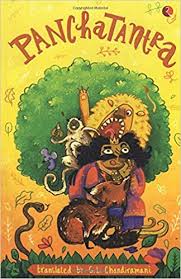Panchatantra Tales
Listen to the Recess! Clip
| Author | Malini Roy |
| Air Date | 12/4/2003 |

Panchatantra Tales Transcript
If you’re interested in hunting up buried treasure, be sure to search for The Panchatantra, a collection of stories from Ancient India. These tales, written in Sanskrit and compiled in 500 AD, have become classics in the heritage of world-literature.
The Panchatantra begins with a short introduction: “Once upon a time in a faraway kingdom, there lived a king named Amarshakti, or ‘immortal might.’ He was revered by all for the wisdom of his rule. Unfortunately, however, he happened to have three foolish sons, who needed a lesson in kingship. The learned Brahmin Vishnusharma began to teach the three adolescent princes the art of kingship, under the guise of five volumes of attractive stories. That is where the name Panchatantra comes from — literally, ‘five treatises.’ These five volumes are called The Loss of Friends, The Winning of Friends, War and Peace, The Loss of Gains and Ill-Considered Action.”
As the titles of the volumes indicate, the Panchatantra is meant to teach worldly wisdom, and its stories glorify practical rather than spiritual knowledge. The famous tale of the clever monkey and the foolish, aggressive crocodile, for instance, emphasizes, for instance, the importance of protecting oneself from hypocritical friends. Another tale, in which hundreds of silly geese outwit a single human hunter illustrates the simple maxim ‘Unity is strength.’ The story of the jackal which becomes a king by virtue of its blue color, but is later discovered and punished, warns one to limit one’s greed. The moral thrust of these stories does not get in the way of their being vivid and witty, as well as timeless and universal.
The Panchatantra is available in several versions in English as well as other languages, in the form of both scholarly texts and attractive picture-books for children. There is even a children’s musical “Here comes the Indosaurus” based upon the collection. The best way to experience them, though, even today, may be to stretch out under the shade of a banyan tree in the Indian heartland and listen to a recital of the tales from the village granny or grandpa.